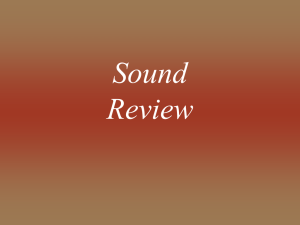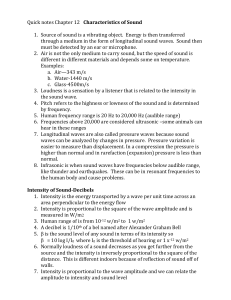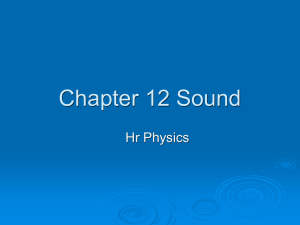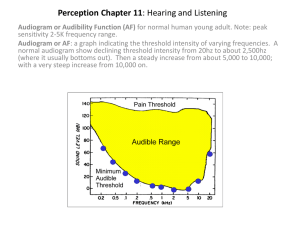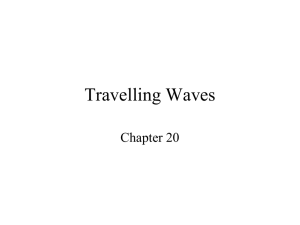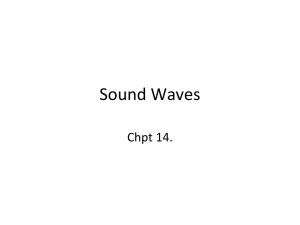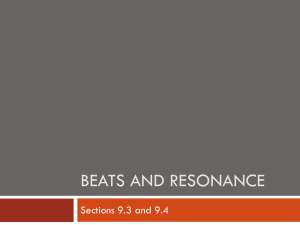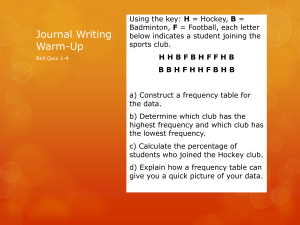Sound
advertisement
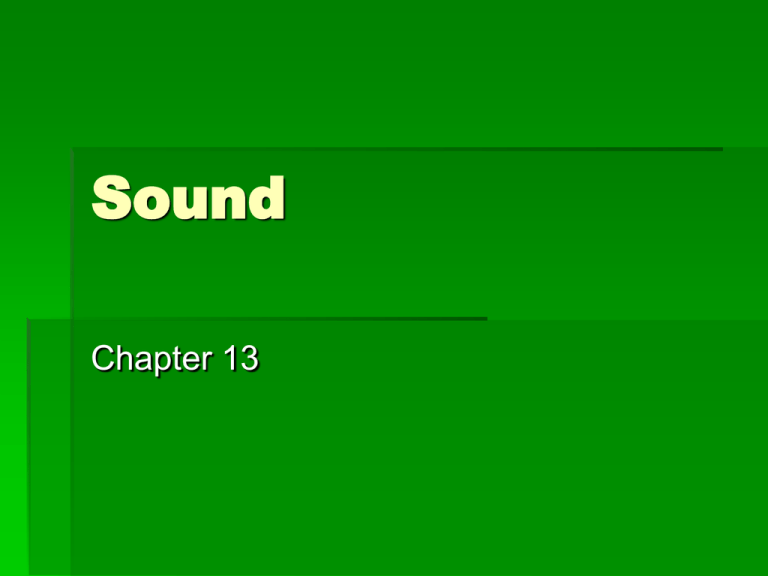
Sound Chapter 13 Sound Waves Sound waves are areas of alternating high and low molecular densities. Longitudinal Caused by vibrations Compression-areas of high molecular density Rarefactions-areas of low molecular density Speed of Sound The speed of sound depends on the medium in which it propagates. Solids Liquids Gases Hot Cold (Fast to Slow) vair 331 0.6T Human Hearing Audible Sounds Humans can hear frequencies (known as pitch) between 20 Hz and 20,000 Hz Frequencies higher than we can hear… Ultrasonic Frequencies lower than we can hear… infrasonic Sound Characteristics Pitch-results from differences in frequency The higher the frequency, the higher the pitch Don’t directly observe wavelength Infrasonic and Ultrasonic Loudness-results from amplitude Logarithmic relationship between intensity and perceived loudness. Increasing intensity by 10 times only results in a doubling of perceived loudness. Intensity Power Intensity Area Rate at which energy flows Inverse square relationship Units of W/m2 We will assume the sound spreads in all directions equally so the area we are dealing with is the surface area of a sphere (4πr2). Intensity and Human Hearing Intensity ranges: Threshold of Hearing to Threshold of Pain 1.0 x 10-12 W/m2 to 1 W/m2 This is a large range: Logarithmic scale compresses this range Use Decibel levels The Decibel Scale Hearing damage starts at 85dB For each 10dB step, the intensity increases by 10 times and the perceived loudness increases by 2 times. Examples 1. Calculate the intensity of the sound waves from an electric guitar’s amplifier at a distance of 5.0 m when its power output is equal to each of the following values: a. 0.25 W b. 0.50 W c. 2.0 W 2. If the intensity of a person’s voice is 4.6 x 10-7 W/m2 at a distance of 2.0 m, how much sound power does that person generate? 3. The power output of a tuba is 0.35 W. At what distance is the sound intensity of the tuba 1.2 x 10-3 W/m2? The Doppler Effect The shift in perceived frequency of a wave due to relative motion between the source and the observer. Observable in both sound (pitch) and light (red and blue shifts) As the sound approaches - higher f As sound leaves - lower f Occurs as either listener or source is moving Forced Vibrations and Natural Frequency Forced Vibration – a vibration that occurs when a periodic force causes an object to vibrate at a particular frequency Singing Natural Frequency – the frequency an object will vibrate at when given a one time force Depends on shape and material of object Resonance The amplified wave that occurs when a forced vibration on an object matches the natural frequency of the object. Makes the wave progressively larger. Swing set example Music Different notes have different mathematical relationships between their frequencies. Specific frequency combinations are considered pleasant (harmony) and others unpleasant (dissonance). 2:1 = Octave (C to the next C) 5:4 = Major Third (C to E) 4:3 = Perfect Forth (C to F) 3:2 = Perfect Fifth (C to G) Instruments The sound produced by the vibration of a piece of the instrument (string, reed, lips) is amplified and shaped through resonance by the rest of the instrument. Standing waves are produced within the instrument at certain frequencies depending on either the properties of the string or the shape and size of the instrument. Strings Physically, wavelength is restricted to certain values. To change those values, the length of the string needs to be changed (different keys on a piano, different finger placements on a guitar) The longest wavelength on the string is the sound you hear as the note being played and is called the fundamental or first harmonic. Wavelengths L 1 2 1 1 2 L The higher frequency vibrations are played simultaneously and are called overtones. Therefore, the next longest wavelength will be the second harmonic or first overtone. L 2 L 3 2 3 L 24 3 2 3 L 4 1 2 L Frequencies 2L n n Since all of the waves are on the same medium and travel at the same speed, there will be a pattern to the frequency as well as the wavelength. v n f n v n fn v nv fn 2L 2L n v f1 2L f n nf1 Closed Pipe Node on one end, antinode on the other. Diagrams help with determining wavelength pattern. Wavelengths and Frequencies 4L n n Where n=1, 3, 5… Closed pipes have only odd harmonics v n f n 1 4 L 1 L 3 4 2 4 3 L 2 L 5 4 3 4 5 L 3 L 1 4 fn v n v nv fn 4L 4L n f n nf1 Open Pipes The same as the closed pipe, however there is an anti-node at each end for molecular movement and a node at each end for pressure variance. Wavelengths and Frequencies 2L n n v n f n L 1 2 1 2 L 1 L 2 L 3 2 3 2 3 L 3 fn v n v nv fn 2L 2L n f n nf1 Beats Beats are a result of two waves with close, but not identical frequencies. A pattern of constructive and destructive interference forms creating a warbling sound. Useful for tuning instruments. Beat frequency is equal to the difference between the two component frequencies. Timbre The unique combination of intensities of fundamental and overtone frequencies that makes instruments sound different when playing the same note. Trumpet Flute Cello Examples 1. What is the fundamental frequency of a 0.2 m long organ pipe that is closed at one end, when the speed of sound in the pipe is 352 m/s? 2. A flute is an open pipe. The length is the flute is approximately 66.0 cm. What are the first three harmonics of a flute when all keys are closed, making the length of air equal to the length of the flute? Use 340 m/s for the speed of sound. 3. What is the fundamental frequency of a guitar string when the speed of waves on the string is 115 m/s and the effective string lengths are as follows: a. b. c. 4. 70.0 cm 50.0 cm 40.0 cm A violin string that is 50.0 cm in length has a fundamental frequency of 440 Hz. What is the speed of the waves on this string?
